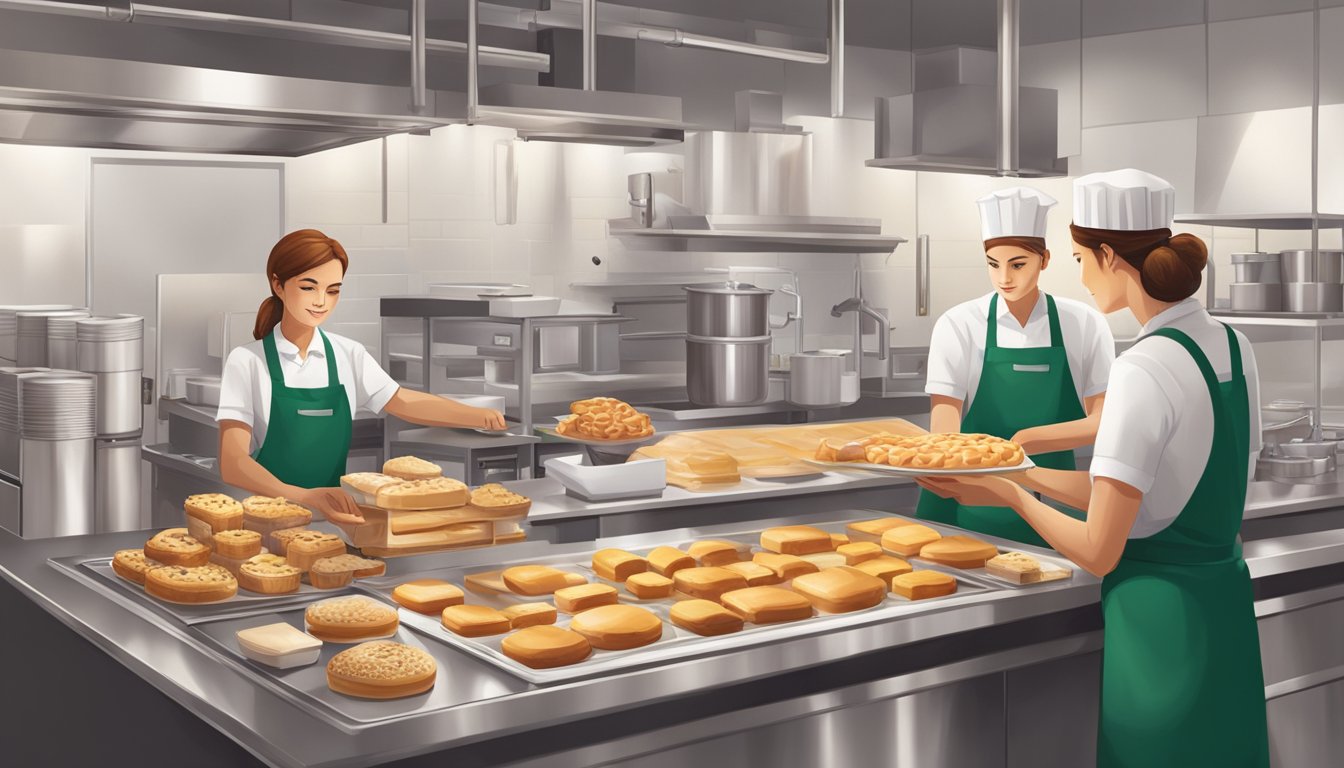Starbucks Corporation, a global coffee giant, extends its commitment to quality beyond its signature beverages to encompass breakfast food offerings. The company’s approach to breakfast food safety and quality control mirrors its rigorous standards for coffee sourcing and preparation. Starbucks implements comprehensive quality assurance measures throughout its supply chain, from ingredient selection to final product delivery, ensuring customers receive safe, high-quality breakfast items.
These measures align with Starbucks’ C.A.F.E. Practices program, which promotes ethical sourcing and sustainability. While originally focused on coffee, this ethos extends to all aspects of Starbucks’ operations, including food safety. The company works closely with suppliers to maintain strict food safety protocols and conducts regular audits to verify compliance with its exacting standards.
Starbucks’ strong brand reputation rests on its ability to consistently deliver quality products. This dedication to excellence in breakfast food safety and quality control reinforces customer trust and supports the company’s position as a leader in the coffee and quick-service restaurant industry.
Quality Control Fundamentals
Starbucks implements rigorous quality control measures throughout its supply chain to ensure consistently high-quality coffee and food products. These practices encompass careful selection of raw materials, proper storage of green beans, and precise roasting techniques.
Raw Materials and Coffee Beans Selection
Starbucks sources premium Arabica coffee beans from select growing regions worldwide. The company’s coffee buyers meticulously evaluate beans based on aroma, flavor profile, body, and acidity. Only 1% of the world’s coffee beans meet Starbucks’ stringent quality standards.
Beans undergo multiple inspections and cupping sessions before approval. Starbucks employs professional tasters called “cuppers” who assess coffee samples for defects and flavor consistency.
The company maintains direct relationships with farmers and cooperatives to ensure ethical sourcing practices and maintain bean quality from farm to roastery.
Green Bean Receiving and Storage
Upon arrival at Starbucks’ roasting facilities, green coffee beans undergo thorough quality checks. Trained inspectors examine incoming shipments for defects, moisture content, and bean size consistency.
Beans are stored in climate-controlled warehouses to preserve freshness and prevent quality degradation. Temperature, humidity, and air circulation are closely monitored to maintain optimal storage conditions.
Starbucks utilizes a first-in-first-out inventory system to ensure beans are roasted at peak freshness. Regular quality audits are conducted on stored beans to verify their condition before roasting.
Roasting Process and Flavor Consistency
Starbucks employs state-of-the-art roasting equipment and techniques to achieve consistent flavor profiles across batches. Master roasters carefully monitor time, temperature, and airflow during the roasting process.
Each coffee blend has a specific roast profile developed to highlight its unique characteristics. Roasters use computer-controlled systems to replicate these profiles with precision.
Post-roasting quality checks include visual inspections, aroma evaluations, and cupping sessions. Samples from each batch are tasted to ensure flavor consistency and adherence to Starbucks’ quality standards.
The company maintains strict protocols for packaging and shipping roasted beans to preserve freshness and flavor integrity during distribution to stores worldwide.
Food Safety Management
Starbucks implements rigorous food safety measures in its breakfast operations. The company utilizes advanced technologies and strict protocols to ensure product quality and safety throughout the production process.
Clean-In-Place (CIP) Capability
Starbucks employs a sophisticated Clean-In-Place (CIP) system in its food processing facilities. This automated cleaning technology allows for thorough sanitization of equipment without disassembly.
The CIP system uses specialized detergents and high-temperature water to clean pipes, tanks, and other processing equipment. It operates on a programmed schedule to maintain consistent cleanliness standards.
CIP technology reduces the risk of human error in cleaning procedures and ensures that hard-to-reach areas are properly sanitized. This system plays a crucial role in preventing bacterial growth and cross-contamination.
Separation of Raw and Finished Product
Starbucks maintains strict separation between raw ingredients and finished products to prevent contamination. The company designs its facilities with physical barriers and designated zones for different stages of production.
Raw materials are stored in temperature-controlled areas separate from processing and packaging zones. The company uses color-coded equipment and uniforms to visually distinguish between raw and finished product areas.
One-way product flow is implemented to minimize the risk of cross-contamination. Finished products are stored and shipped using dedicated equipment and vehicles to maintain separation throughout the supply chain.
Cross-Contamination Prevention
Starbucks employs multiple strategies to prevent cross-contamination in its breakfast food production. The company adheres to Global Food Safety Initiative (GFSI) standards and British Retail Consortium guidelines.
Employee training is a key component of cross-contamination prevention. Staff members receive regular education on proper handwashing techniques, equipment sanitation, and allergen management.
The company uses back-in dock doors for deliveries, reducing the risk of outside contaminants entering production areas. Air filtration systems and positive air pressure in processing zones further minimize the entry of airborne contaminants.
Allergen control measures include dedicated production lines for allergen-free products and thorough cleaning protocols between production runs. These practices help ensure the safety of customers with food allergies.
Sourcing and Ethical Practices
Starbucks prioritizes responsible sourcing and ethical practices throughout its supply chain, with a particular focus on coffee. The company has implemented comprehensive programs to ensure quality, sustainability, and positive impacts on farming communities.
Coffee Sourcing and Supply Chain
Starbucks sources its coffee from over 400,000 farmers across 30 countries. The company works directly with farmers, cooperatives, and exporters to maintain a sustainable supply of high-quality coffee beans.
Starbucks emphasizes long-term relationships with suppliers, often spanning decades. This approach allows for better quality control and consistent flavor profiles.
The company also invests in local infrastructure and processing facilities in coffee-growing regions. These investments help improve efficiency and reduce transportation costs.
C.A.F.E. Practices and Ethical Sourcing
Coffee and Farmer Equity (C.A.F.E.) Practices is Starbucks’ cornerstone ethical sourcing program. Launched in 2004, it was one of the industry’s first comprehensive ethical sourcing standards.
The program includes over 200 indicators covering economic, social, and environmental criteria. These standards help ensure fair wages, safe working conditions, and sustainable farming practices.
Third-party verification is a key component of C.A.F.E. Practices. Independent auditors regularly assess farms and processing facilities against the program’s rigorous standards.
As of 2025, 99% of Starbucks’ coffee is verified as ethically sourced through C.A.F.E. Practices.
Support for Coffee Farmers and Sustainability
Starbucks provides various forms of support to coffee farmers to promote sustainability and improve livelihoods. The company offers farmer loans to help with equipment purchases and crop financing.
Environmental leadership is a priority. Starbucks works with farmers to implement water conservation techniques, reduce chemical use, and protect biodiversity on coffee farms.
The company invests in farmer support centers in key coffee-growing regions. These centers provide free agronomic advice and training to help farmers improve crop yields and quality.
Starbucks also supports social programs in coffee communities, including investments in education, healthcare, and clean water access.
Sustainable and Environmental Initiatives

Starbucks has implemented robust sustainability programs focused on environmental conservation and responsible sourcing. The company partners with organizations to protect ecosystems, adapt to climate change, and improve agricultural practices.
Conservation International Partnerships
Starbucks collaborates closely with Conservation International to enhance coffee farming sustainability. This partnership helps protect biodiversity in coffee-growing regions through:
• Agroforestry techniques that integrate trees into coffee farms
• Soil conservation practices to prevent erosion
• Water management systems to reduce waste and pollution
The initiative has reached over 100,000 farmers across Latin America, Africa, and Asia. It provides training on sustainable growing methods and helps farmers access eco-friendly tools and resources.
Climate Change Adaptation Strategies
To address the impacts of global warming on coffee production, Starbucks has developed several climate adaptation strategies:
• Drought-resistant coffee plant varieties
• Shade-grown coffee to protect crops from extreme heat
• Improved irrigation systems to conserve water
The company also invests in renewable energy for its stores and roasting facilities. Solar panels and wind turbines now power over 75% of Starbucks’ global operations, significantly reducing carbon emissions.
Biodiversity and Soil Health Improvement
Starbucks emphasizes biodiversity protection and soil health in its supply chain. Key initiatives include:
• Promoting crop diversity to enhance soil nutrients
• Limiting chemical fertilizer and pesticide use
• Supporting pollinator habitats near coffee farms
The company has planted over 30 million trees on and around coffee farms. This effort improves soil stability, provides natural pest control, and creates wildlife corridors in agricultural areas.
Innovation in Processing and Production

Starbucks has implemented cutting-edge technologies and processes to enhance food safety and product quality. The company’s focus on innovation spans advanced automation, specialized soluble coffee production, and ongoing improvements across its manufacturing operations.
Advanced Automation in Manufacturing
Starbucks utilizes sophisticated automation systems to minimize human intervention in food processing. Specialized pipes and equipment transport ingredients and products throughout the manufacturing facilities. A centralized control room allows operators to monitor and adjust processes in real-time using live data feeds. This automation reduces contamination risks and ensures consistent product quality.
Nitrogen blanketing technology protects coffee during processing by creating an oxygen-free environment. This preserves the flavor, texture, and color of the coffee as it moves through the production line. Temperature control systems maintain optimal conditions after the extraction phase to further safeguard product integrity.
Soluble Coffee Plant Technology
The Starbucks VIA Ready Brew soluble coffee plant showcases innovative food safety measures. A closed-loop processing system isolates the coffee from outside contaminants. Advanced roasting equipment follows precise time-temperature curves to achieve the desired flavor profile for each coffee variety.
Clean-in-place (CIP) technology enables thorough sanitization of equipment between production runs without manual disassembly. This improves efficiency while maintaining rigorous hygiene standards. The plant’s design also incorporates specialized packaging systems to seal in freshness and protect the final product.
Continuous Improvement and Innovation
Starbucks maintains a culture of ongoing innovation in its manufacturing processes. The company regularly evaluates new technologies and methods to enhance food safety and product quality. Cross-functional teams collaborate to identify opportunities for improvement across the supply chain.
Recent initiatives have focused on reducing environmental impact while maintaining safety standards. This includes implementing more energy-efficient equipment and exploring sustainable packaging options. Starbucks also invests in research and development to create new product formulations that meet evolving consumer preferences without compromising on quality or safety.
Quality Assurance Programs and Certifications

Starbucks implements rigorous quality assurance programs and certifications to maintain high standards across its global operations. These initiatives encompass strict quality standards, comprehensive supplier verification processes, and oversight of the entire supply chain.
Quality Standards and Certification
Starbucks adheres to stringent quality standards and pursues relevant certifications to ensure food safety and product excellence. The company voluntarily follows certification programs like the British Retail Consortium (BRC) for its soluble coffee production. This commitment extends beyond minimum regulatory requirements.
Starbucks’ ‘Quarter of Quality’ program, launched in 2014, engages partners annually on food safety topics. This initiative keeps quality control at the forefront of employees’ minds through interactive and educational activities.
Supplier and Product Verification
The company conducts regular audits and assessments of supplier facilities. These evaluations focus on compliance with Starbucks Food Standards and overall quality control measures.
Suppliers bear the cost of these audits, emphasizing the company’s dedication to maintaining high standards. Starbucks reserves the right to assess facilities producing branded, non-branded, or custom-made products.
Global Supply Chain Oversight
Starbucks employs a science-based food safety system to anticipate risks in its rapidly changing global supply chain. This approach aims to create an industry-leading culture of food safety and prevention across over 34,000 retail locations.
The company’s global supply chain oversight includes farmer support programs. These initiatives help ensure quality standards are met from the source of raw materials through to the final product.
Third-party verification plays a crucial role in maintaining objectivity and credibility in Starbucks’ quality assurance efforts. This external validation reinforces the company’s commitment to food safety and product quality.
Customer-Driven Quality Approach
Starbucks prioritizes customer satisfaction through comprehensive barista training, robust feedback systems, and a commitment to meeting evolving consumer preferences. This approach ensures high-quality products and exceptional service across their global network of stores.
Barista Training and Customer Service
Starbucks invests heavily in barista training to maintain consistent quality and service standards. New hires undergo an intensive program covering coffee knowledge, drink preparation, and customer interaction skills. Baristas learn to craft beverages to exact specifications while engaging customers in a friendly manner.
The company also emphasizes product knowledge, enabling staff to answer questions about coffee origins and flavor profiles. Regular skill assessments and ongoing training help baristas stay up-to-date with new products and brewing techniques. This focus on education empowers employees to deliver personalized recommendations and create positive customer experiences.
Monitoring and Integrating Customer Feedback
Starbucks actively seeks and analyzes customer feedback to drive improvements. The company utilizes multiple channels:
- In-store comment cards
- Online surveys
- Social media monitoring
- Mobile app feedback
Customer insights inform product development, store design, and service enhancements. For example, feedback led to the introduction of alternative milk options and the development of the Starbucks Rewards program.
Starbucks also employs mystery shoppers to evaluate store performance and adherence to quality standards. This data helps identify areas for improvement in individual locations and across the broader network.
Commitment to Customer Satisfaction
Starbucks’ dedication to customer satisfaction extends beyond its products. The company strives to create a welcoming “third place” between home and work. Store designs prioritize comfort and functionality, with ample seating and free Wi-Fi.
Starbucks’ generous return policy allows customers to request a new drink if unsatisfied, reinforcing their quality guarantee. The company also adapts to local tastes, offering region-specific menu items while maintaining core product consistency.
Partnerships with delivery services and the development of drive-thru and mobile ordering options demonstrate Starbucks’ commitment to convenience. These initiatives aim to meet diverse customer needs and preferences in an ever-changing coffee industry landscape.




